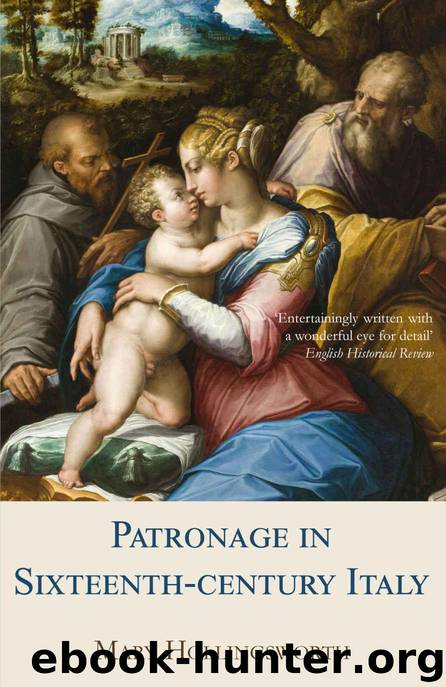Patronage in Sixteenth Century Italy by Hollingsworth Mary

Author:Hollingsworth, Mary [Hollingsworth, Mary]
Language: eng
Format: epub
Tags: Art, History, Renaissance
ISBN: 9781910198568
Google: s4fPrQEACAAJ
Publisher: Thistle Publishing
Published: 2014-12-02T05:00:00+00:00
The Della Rovere in Urbino and Pesaro
Federigo da Montefeltro, created Duke of Urbino by Sixtus IV (1474), amassed a fortune as a soldier and went on to transform his mountain fortress into a superb city, his patronage of scholars making it a major intellectual centre.16 His son Guidobaldo (1482–1508) fostered the city's reputation for courtly elegance and learning, eloquently described by Castiglione in Il Cortegiano, and in turn made his nephew Francesco Maria della Rovere (1508–38) his heir, celebrating the event in Raphael's diptych of St George and St Michael (1504). The choice of saints alluded to their membership of royal chivalric orders: Guidobaldo was a Knight of the Garter and Francesco Maria a Knight of St Michael.17 Francesco Maria I was also a nephew of Julius II, who appointed him Prefect of Rome and added the papal fief of Pesaro to his dominions (1512). He was expelled by Leo X, who gave Urbino to his nephew, Lorenzo de' Medici (1516–21),18 but returned after Leo X's death and the family ruled Urbino and Pesaro until the early seventeenth century. He was succeeded by his son Guidobaldo II (1538–74) and grandson Francesco Maria II (1574–1626). The latter died without a son, and the fief then reverted to Rome. The duchy was not rich – annual revenues in 1516 from its three main cities, Urbino, Senigallia and Pesaro, amounted to only 25,000 ducats19 – but all three dukes augmented this with income from military service. Determined to rival the richer dukes to whom they were related, the Gonzaga and the Farnese, they spent lavishly on embellishing their dominions with impressive evidence of their prestige.
A successful but hot-tempered soldier, Francesco Maria I (1508–38) fought for Florence, the Papacy, Venice and the Emperor, wrote a treatise on defence,20 and murdered the unscrupulous Cardinal Alidosi, whom he blamed for his defeat at Bologna (1511). He married Eleonora, daughter of Marquis Francesco Gonzaga, cementing links between Urbino and Mantua, and he secured his title to Urbino by abandoning his French allies in favour of Charles V, becoming one of the Emperor's generals and carrying the imperial sword at the coronation. The arts provided propaganda for his prestige – as Julius II's heir, he was involved in Michelangelo's ill-fated project for the Pope's tomb.21 Under his rule Urbino's cultural reputation flourished: Cardinal Bibbiena's comedy, La Calandria, was first performed at Carnival (1513)22 and lavish entertainments were staged for state ceremonies. Influenced by his brother-in-law, Federigo Gonzaga (see Chapter 16), he commissioned Titian for religious and mythological paintings, and portraits of his ancestors, Sixtus IV, Julius II and Guidobaldo da Montefeltro, and of famous rulers, notably Charles V and François I.23 He owned Titian's La Bella (1536), an example of the fashion for images of female beauty.24 Titian's portraits of Francesco Maria I (pl. 40) and Eleonora (1536–7) proclaimed their rank. Eleonora was ostentatiously dressed in expensive clothes and jewels, while the Duke wore shining black armour, sent to Venice for Titian to copy, and held his baton as commander of the Venetian armies.
Download
This site does not store any files on its server. We only index and link to content provided by other sites. Please contact the content providers to delete copyright contents if any and email us, we'll remove relevant links or contents immediately.
| Africa | Americas |
| Arctic & Antarctica | Asia |
| Australia & Oceania | Europe |
| Middle East | Russia |
| United States | World |
| Ancient Civilizations | Military |
| Historical Study & Educational Resources |
Room 212 by Kate Stewart(5037)
The Crown by Robert Lacey(4723)
Endurance: Shackleton's Incredible Voyage by Alfred Lansing(4676)
The Iron Duke by The Iron Duke(4292)
The Rape of Nanking by Iris Chang(4138)
Joan of Arc by Mary Gordon(4014)
Killing England by Bill O'Reilly(3952)
Say Nothing by Patrick Radden Keefe(3903)
I'll Give You the Sun by Jandy Nelson(3358)
Shadow of Night by Deborah Harkness(3303)
Hitler's Monsters by Eric Kurlander(3268)
Mary, Queen of Scots, and the Murder of Lord Darnley by Alison Weir(3149)
Blood and Sand by Alex Von Tunzelmann(3138)
Darkest Hour by Anthony McCarten(3071)
Eleanor & Park by Rainbow Rowell(3063)
Margaret Thatcher: The Autobiography by Thatcher Margaret(3029)
Red Famine: Stalin's War on Ukraine by Anne Applebaum(2873)
Book of Life by Deborah Harkness(2867)
The One Memory of Flora Banks by Emily Barr(2803)
